High Impact Tutoring Built By Math Experts
Personalized standards-aligned one-on-one math tutoring for schools and districts
In order to access this I need to be confident with:
How to find probability How to calculate probability Conditional probabilityProbability notation
Here you will learn about probability notation, including set notation.
Students will first learn about probability notation as part of statistics and probability in 7 th grade.
What is probability notation?
Probability notation is an efficient way of writing the probability of events happening or not happening.
To do this we use set notation, which is used when working with Venn diagrams. Events are usually notated using capital letters, as well as the use of some Greek letters.
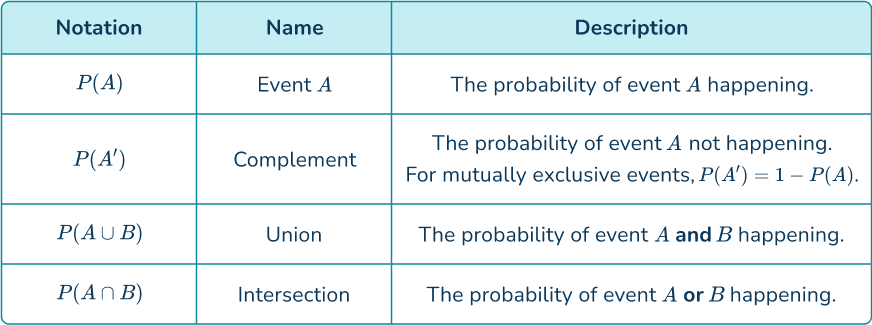
Let’s look at some examples.
If you were to roll a fair six-sided dice and event A is rolling a six, a more efficient way of writing ‘what is the probability of rolling a 6 ’, you could write P(A) or P(6).
If you were to roll a fair six-sided dice and event A is rolling a six, a more efficient way of writing ‘what is the probability of not rolling a 6 ’, you could write P(A').
This links to Venn diagrams (shown below) as they show event A and anything that is not event A.
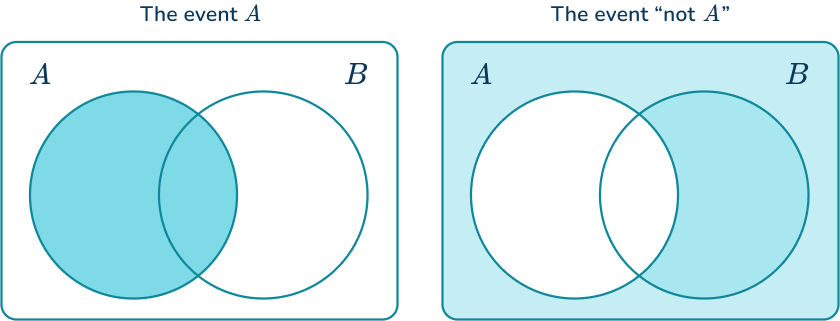
Step-by-step guide: Venn diagrams
![[FREE] Probability Check for Understanding Quiz (Grade 7 to 12)](https://thirdspacelearning.com/wp-content/uploads/2023/07/Probability-check-for-understanding-quiz-listing-image.png)
[FREE] Probability Check for Understanding Quiz (Grade 7 to 12)
![[FREE] Probability Check for Understanding Quiz (Grade 7 to 12)](https://thirdspacelearning.com/wp-content/uploads/2023/07/Probability-check-for-understanding-quiz-listing-image.png)
Use this quiz to check your grade 7 to 12 students’ understanding of probability. 15+ questions with answers covering a range of 7th to 12th grade probability topics to identify areas of strength and support!
DOWNLOAD FREE![[FREE] Probability Check for Understanding Quiz (Grade 7 to 12)](https://thirdspacelearning.com/wp-content/uploads/2023/07/Probability-check-for-understanding-quiz-listing-image.png)
[FREE] Probability Check for Understanding Quiz (Grade 7 to 12)
![[FREE] Probability Check for Understanding Quiz (Grade 7 to 12)](https://thirdspacelearning.com/wp-content/uploads/2023/07/Probability-check-for-understanding-quiz-listing-image.png)
Use this quiz to check your grade 7 to 12 students’ understanding of probability. 15+ questions with answers covering a range of 7th to 12th grade probability topics to identify areas of strength and support!
DOWNLOAD FREEUnion
P(A\cup{B}) or ‘A union B’ is the chance of picking any outcome that is satisfied by event A or event B or both.
In a Venn diagram, it would be presented like this:
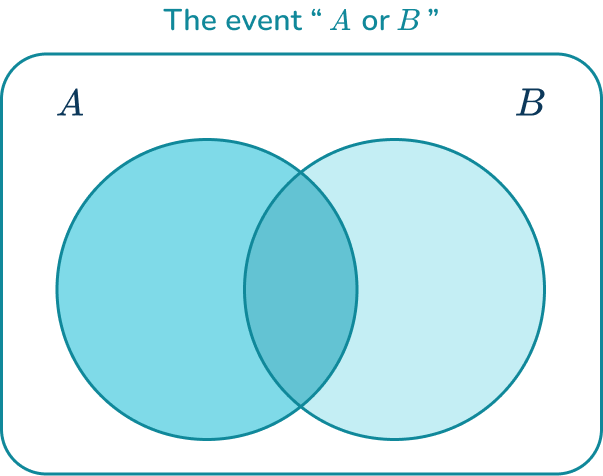
For example, ξ is the set of numbers 1-12. \, A and B are subsets of ξ where A= multiples of 3 and B= multiples of 4. One of the numbers is picked at random. Find the probability P(A\cup{B}).
Event A are the multiples of 3\text{:} \, 3, \, 6, \, 9, \, 12.
Event B are the multiples of 4\text{:} \, 4, \, 8, \, 12.
The numbers 1, \, 2, \, 5, \, 7, \, 10 and 11 are not in event A or event B.
There are 12 possible outcomes, the numbers 1 to 12.
There are a total of 6 possible outcomes (12 is only counted once even though it satisfies event A and event B).
So P(A\cup{B})=\cfrac{6}{12}.
Note: You can simplify probabilities if specified in the question but it can be easier to leave them in their original, unsimplified form if they are used in further calculations.
Intersection
P(A\cap{B}) or ‘A intersection B’ is the chance of picking any outcome that is satisfied by event A and event B, the joint probability of the events.
In a Venn diagram, it would be presented like this:
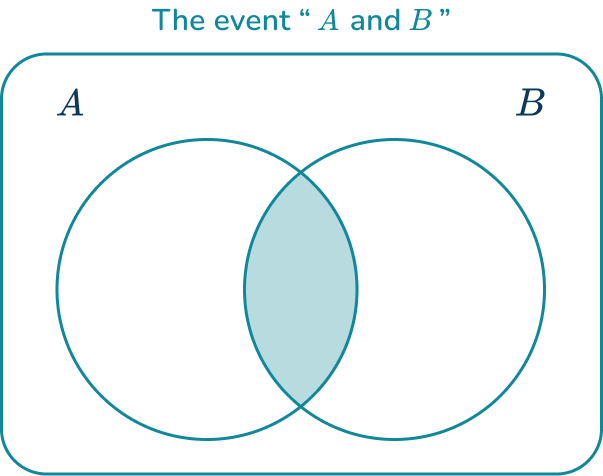
For example, ξ is the set of numbers 1-12. \, A and B are subsets of ξ where A= multiples of 3 and B= multiples of 4. One of the numbers is picked at random. Find the probability P(A\cap{B}).
Event A are the multiples of 3\text{:} \, 3, \, 6, \, 9, \, 12.
Event B are the multiples of 4\text{:} \, 4, \, 8, \, 12.
The numbers 1, \, 2, \, 5, \, 7, \, 10 and 11 are not in event A or event B.
There are 12 possible outcomes, the numbers 1 to 12.
There is only 1 number that satisfies event A and event B, the number 12.
So P(A\cap{B})=\cfrac{1}{12}.
Mutually exclusive and non-mutually exclusive events
Mutually exclusive events cannot happen at the same time, for example, rolling a 4 and a 5 on a standard 6 -sided dice.
Non-mutually exclusive events can happen at the same time, for example, rolling a 4 and an even number on a standard 6 -sided dice. It is necessary to determine whether events are therefore mutually exclusive when considering the union of events.
If events are mutually exclusive, then P(A\cup{B})=P(A)+P(B).
If events are not mutually exclusive, then P(A\cup{B})=P(A)+P(B)-P(A\cap{B}).
Step-by-step guide: Mutually Exclusive Events
Here are some more common probability notations, ranging from basic notations in middle school to more complex notations in high school and beyond:
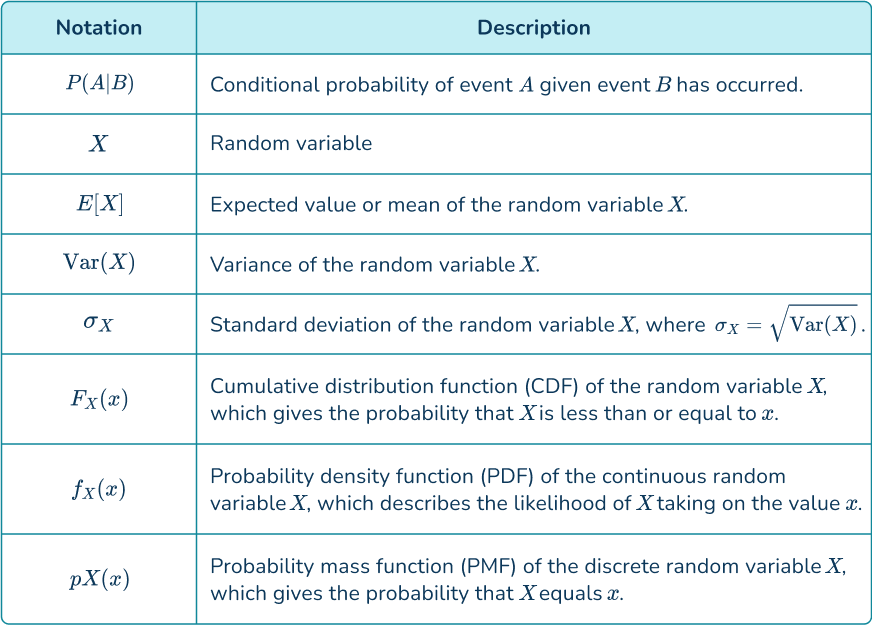
What is probability notation?
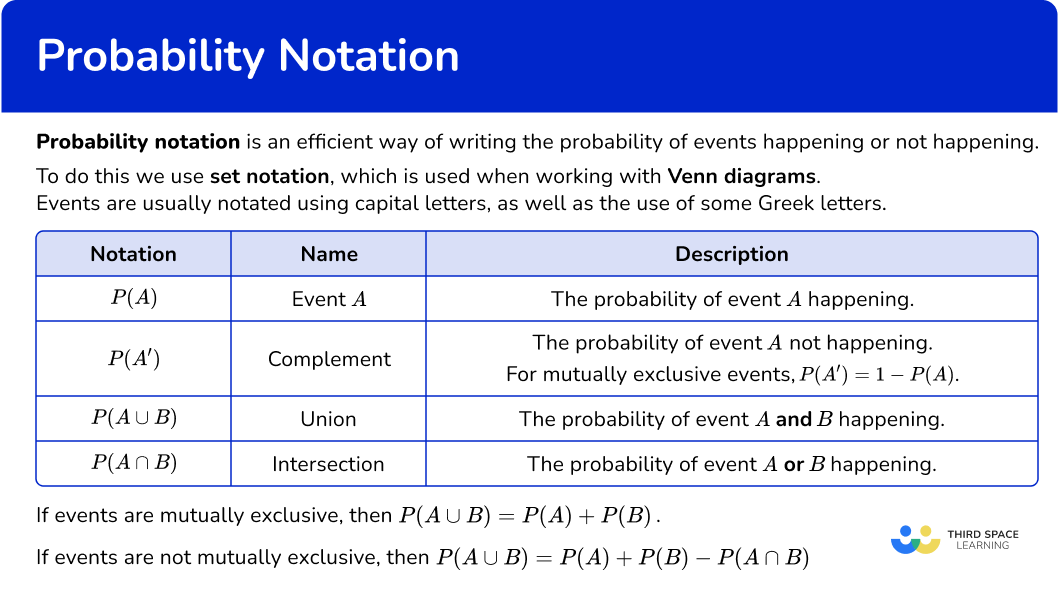
Common Core State Standards
How does this relate to 7 th grade math?
- Grade 7 – Statistics and Probability (7.SP.C.5)
Understand that the probability of a chance event is a number between 0 and 1 that expresses the likelihood of the event occurring. Larger numbers indicate greater likelihood.
A probability near 0 indicates an unlikely event, a probability around \cfrac{1}{2} indicates an event that is neither unlikely nor likely, and a probability near 1 indicates a likely event.
How to use probability notation
In order to use probability notation to calculate the probability of an event:
- Identify the event(s) needed.
- Identify how many possible outcomes there are.
- Identify how many times the event(s) occur.
- Write this as a probability.
Probability notation examples
Example 1: probability of an event
A box contains a variety of 2D shapes:

Event A\text{:} selecting a circle.
Event B\text{:} selecting a square.
Event C\text{:} selecting a triangle.
Event D\text{:} selecting a star.
Calculate P(C).
- Identify the event(s) needed.
Event C is selecting a triangle.
2Identify how many possible outcomes there are.
There are 12 possible outcomes as there are 12 shapes in the box.
3Identify how many times the event(s) occur.
There are 3 triangles so the expected value is 3.
4Write this as a probability.
P(C)=\cfrac{3}{12}Example 2: probability of an event not happening
A bowl of fruit contains: 3 apples, 2 oranges, 3 bananas, and 2 plums.

Event A\text{:} picking an apple.
Event B\text{:} picking a banana.
Event C\text{:} picking a plum.
Event D\text{:} picking an orange.
What is P(D')?
Identify the event(s) needed.
Event D is the probability of picking an orange. In this example, we want the complement of D , so we want any fruit that is not an orange.
Identify how many possible outcomes there are.
There are 10 possible outcomes as there are 10 pieces of fruit in the bowl.
Identify how many times the event(s) occur.
There are 8 pieces of fruit that are not an orange.
Write this as a probability.
Example 3: probability of event A or event B or both
A fast food restaurant records what their customers ate on Monday between 10 am and 11 am. This data is used to predict what customers will buy at the same time on the following Monday.

Calculate P(A\cup{C}) .
Identify the event(s) needed.
The outcomes are Pizza or Chicken nuggets.
Identify how many possible outcomes there are.
The total sales is 146+242+112=500.
Identify how many times the event(s) occur.
Event A\text{:} \, 146
Event C\text{:} \, 112.
146+112=258
There are a total of 258 possible outcomes.
Write this as a probability.
Example 4: probability of event A or event B or both
A fair, eight sided spinner is spun.
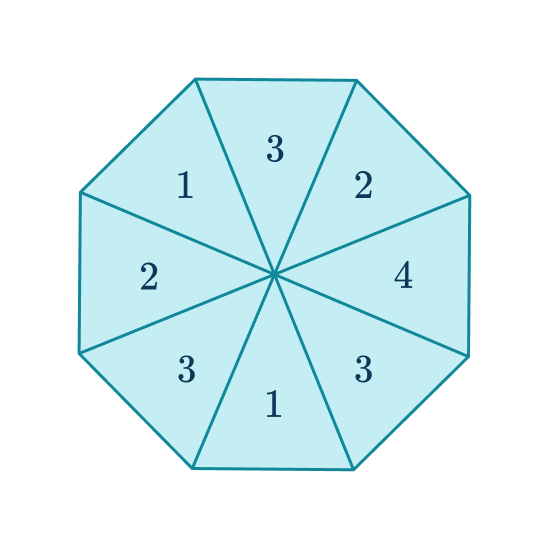
Event A\text{:} land on 3.
Event B\text{:} land on an even number.
Calculate P(A\cup{B}).
Identify the event(s) needed.
The spinner needs to land on a 3 or an even number (here 2 or 4 ).
Identify how many possible outcomes there are.
There are 8 sections on the spinner.
Identify how many times the event(s) occur.
Event A\text{:} \, 3 sections
Event B\text{:} \, 3 sections
There are a total of 6 possible outcomes.
Write this as a probability.
Example 5: probability of event A and event B
A fair, eight sided spinner is spun.
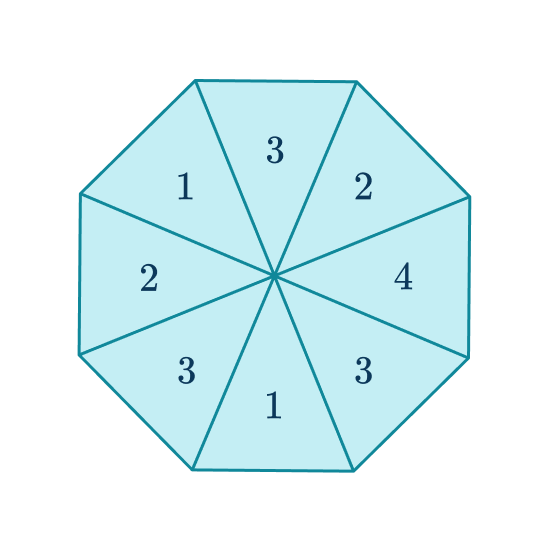
Event A\text{:} land on an odd number.
Event B\text{:} land on a prime number.
Calculate P(A\cap{B}).
Identify the event(s) needed.
The spinner needs to land on an odd number and a prime number.
The odd numbers on the spinner are: 1 and 3.
The prime numbers on the spinner are: 2 and 3.
You need the sections that are odd and prime and so you need the sections labeled 3 as this number is odd and prime. The other numbers are not both.
Identify how many possible outcomes there are.
There are 8 sections on the spinner.
Identify how many times the event(s) occur.
There are 3 sections labeled 3.
Write this as a probability.
Example 6: probability of event A and event B
A standard, fair, 6 -sided dice is rolled.

Event A\text{:} Roll a multiple of 3.
Event B\text{:} Roll a 1.
Calculate P(A\cap{B}).
Identify the event(s) needed.
The dice needs to land on multiple of 3 and a 1.
Identify how many possible outcomes there are.
There are 6 faces on the dice.
Identify how many times the event(s) occur.
1 is not a multiple of 3 so there are no faces that have an outcome of a multiple of 3 and a 1.
There are 0 possible outcomes.
Write this as a probability.
0 (Impossible).
Teaching tips for probability notation
- Introduce and explain the statistical symbols used in probability notation, such as P(A), \, P(B|A), \, A\cup{B}, \, A\cap{B}, and A'.
- Compare and contrast different notations used in probability theory, such as conditional probability versus joint probability.
- Provide exercises that follow a linear progression, where each problem builds on the understanding gained from the previous one. This helps reinforce learning and shows the interconnectedness of probability concepts.
- Use simple examples to introduce the concept of the empty set (∅). For example, explain that if you are rolling a fair die, the event of rolling a 7 is an empty set because it is impossible.
Easy mistakes to make
- Confusing ‘union’ and ‘intersection’
P(A\cup{B}) and P(A\cap{B}) are similar and can easily be interchanged due to confusion.
- Assuming all expected values are \textbf{A}\cup\textbf{B}
Some values may be in the universal set but not be satisfied by event A or event B, it might sit outside.
For example, this Venn diagram displays two numbers, 1 and 9, that are not satisfied by event A or event B but are in the universal set. The universal set is notated with the Greek letter ξ.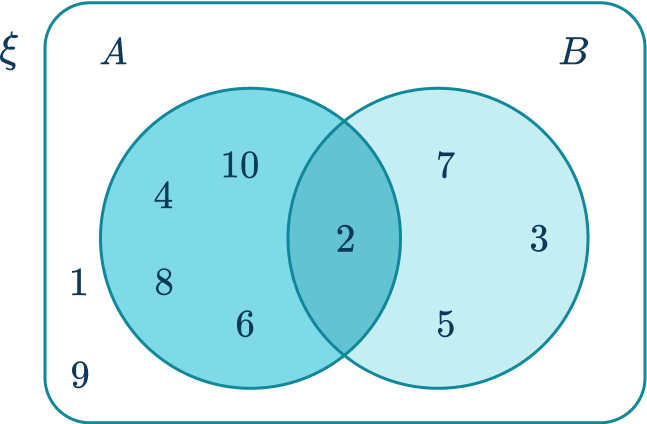
- Incorrect use of and/or rule for independent events and conditional probability
When calculating the probability of event A or event B, you need to add the probabilities.
When calculating the probability of event A and event B, you need to multiply the probabilities.
- Misinterpreting the notation
Set notation includes the use of capital letters, lowercase letters, and Greek letters. These are specific and cannot be interchanged.
For example, set ‘A’ could be even numbers, and set ‘a’ could be odd numbers.
- Not listing outcomes
When there are two or more events we need to use systematic listing strategies to include all the permutations.
Related probability lessons
Practice probability notation questions
1. A paper bag contains 8 marbles of different colors.
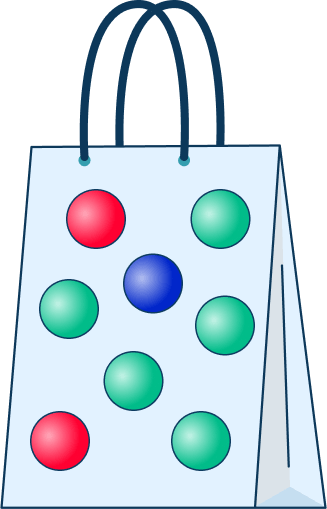
Event A\text{:} picking a blue marble.
Event B\text{:} picking a green marble.
Event C\text{:} picking a red marble.
Work out P(B).




The notation P(B) means we want the probability of event B. Event B is picking a green marble.
There are 5 green marbles and 8 marbles in total. So, P(B)=\cfrac{5}{8}.
2. A paper bag contains 8 marbles of different colors.
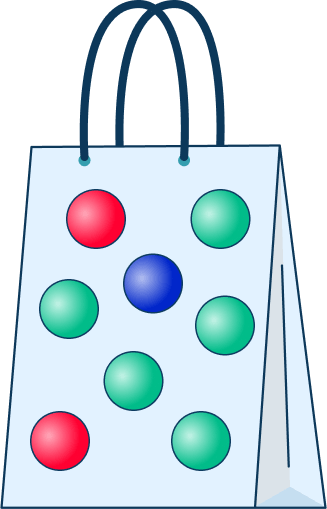
Event A\text{:} picking a blue marble.
Event B\text{:} picking a green marble.
Event C\text{:} picking a red marble.
Work out P(C').




The notation P(C') means we want the probability that it is not event C. Event C is picking a red marble.
There are 2 red marbles and 6 marbles that are not red.
There are 8 marbles in total. So, P(C’)=\cfrac{6}{8}.
3. A fair six-sided dice is rolled.

Event A is the dice landing on an even number.
Event B is the dice landing on ‘1’.
Calculate P(A\cup{B}).




The notation P(A\cup{B}) means the probability of the outcome being in event A, or B, or both.
There are three even numbers and one ‘1’. Therefore there are 4 possible outcomes that satisfy event A, event B, or both.
There are 6 outcomes in total. So, P(A\cup{B})=\cfrac{4}{6}.
4. A fair six-sided dice is rolled.

Event A is the dice landing on an even number.
Event B is the dice landing on a prime number.
Calculate P(A\cup{B}).




The notation P(A\cup{B}) means in A, or B, or both.
There are three even numbers (2, 4, 6) and three prime numbers (2, 3, 5). \, ‘2’ satisfies both event A and event B so there are 5 possible outcomes that satisfy event A or event B or both.
There are 6 possible outcomes in total. So, P(A\cup{B})=\cfrac{5}{6}.
5. A deck of cards is shuffled and a card is picked at random.
Event A\text{:} Diamond
Event B\text{:} Picture Card (King, Queen or Jack)
Calculate P(A\cap{B}).




The notation P(A\cap{B}) means the probability of an outcome in A and B.
There are 13 Diamond cards in a deck. Of those cards, 3 are Picture cards, so 3 cards are a diamond and a picture card out of the total number of cards (52).
So, P(A\cap{B})=\cfrac{3}{52}.
6. A deck of cards is shuffled and a card is picked at random.
Event A\text{:} Diamond
Event B\text{:} Picture Card (King, Queen or Jack)
Calculate P(A\cup{B}).




The notation P(A\cup{B}) means the probability of an outcome in A or B. There are 13 Diamond cards in a deck. There are 12 Picture cards in a deck.
However, 3 of these picture cards are diamonds, so there are 13+12-3=22 cards in the deck that are diamonds or picture cards, or both out of the total number of cards (52).
So, P(A\cup{B})=\cfrac{22}{52}.
Probability notation FAQs
Probability notation refers to the symbolic representation used to describe and calculate probabilities in statistics and probability theory.
The probability of the entire sample space S is always 1, represented as P(S)=1.
Yes, random variables are used in probability notation, represented by uppercase Roman letters (example, random variable X or Y ), and denote probabilities such as P(X=x) for specific values and E(X) for the expected value.
In probability notation, Bayes’ Theorem is represented as follows:
Given two events A and B\text{:} \, P(A|B)=\cfrac{P(B|A)\cdot{P(A)}}{P(B)}
Cumulative distribution functions (CDFs) are typically denoted by F_{X}(x) where X is the random variable and x is a specific value.
The next lessons are
- Compound probability
- Probability distribution
- Units of measurement
Still stuck?
At Third Space Learning, we specialize in helping teachers and school leaders to provide personalized math support for more of their students through high-quality, online one-on-one math tutoring delivered by subject experts.
Each week, our tutors support thousands of students who are at risk of not meeting their grade-level expectations, and help accelerate their progress and boost their confidence.

Find out how we can help your students achieve success with our math tutoring programs.
[FREE] Common Core Practice Tests (3rd to 8th Grade)
Prepare for math tests in your state with these 3rd Grade to 8th Grade practice assessments for Common Core and state equivalents.
Get your 6 multiple choice practice tests with detailed answers to support test prep, created by US math teachers for US math teachers!